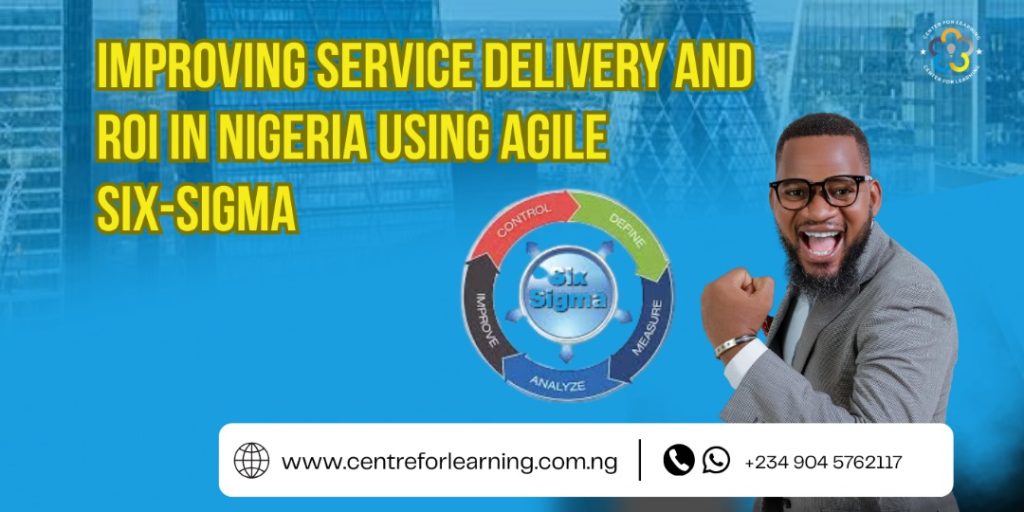CFL INSIGHT PAGE
Improving Service Delivery and ROI in Nigeria Using Agile Six Sigma
Nigeria’s business landscape is evolving rapidly. Organizations must navigate a complex mix
of opportunities and challenges: inflationary pressures, a relatively stable but high exchange
rate (₦1,500–₦1,600 to the dollar), rising operational costs, and an increasingly competitive
market where customers demand speed, consistency, and quality. On a positive note, fuel
prices have stabilized, and initiatives such as the Dangote Refinery and government
strategies promoting compressed natural gas (CNG) trucks promise to reduce energy and
logistics costs further.
In this context, Nigerian companies have a unique opportunity: combine external cost
stabilization with internal process excellence to improve service delivery, increase
productivity, and maximize Return on Investment (ROI). One proven approach is Six Sigma,
a globally recognized methodology for process improvement—but it is critical to
understand that Six Sigma is agile, iterative, and transformational. It is not a plug-and-play
solution; transformation occurs progressively through cycles of assessment, improvement,
and refinement.
Why Service Delivery is Critical
Service delivery is no longer just an operational concern—it is a strategic differentiator. In
sectors such as banking, telecoms, healthcare, logistics, and construction, service quality
directly impacts customer retention, profitability, and brand reputation.
– Customer Expectations Are Rising: Nigerian consumers, empowered by fintech, ecommerce, and digital banking, demand faster, seamless, and reliable service. A single
negative experience can lead to customer churn.
– Operational Inefficiencies Reduce ROI: Rework, delays, and waste directly translate into
lost revenue. For instance, a bank processing loan applications inefficiently may incur
higher administrative costs while frustrating clients who could turn to competitors.
– Competitive Pressure: Local startups and multinational firms in Nigeria are raising the bar
on service quality. Organizations that fail to adapt risk losing market share.
Improving service delivery is no longer optional—it is a strategic imperative that directly
affects productivity and ROI.
What is Agile Six Sigma and Why It Matters
Six Sigma is a structured, data-driven methodology designed to improve processes, reduce
defects, and enhance customer satisfaction. While it originated in manufacturing, it has
proven effective across service sectors, logistics, healthcare, finance, and more.
A key feature of Six Sigma is its agile and iterative nature. It does not work as a plug-andplay solution. Transformation occurs progressively through cycles of analysis,
improvement, measurement, and refinement.
The DMAIC framework—Define, Measure, Analyze, Improve, Control—provides a
structured roadmap while allowing flexibility and iteration. While DMAIC is logically
sequential, in practice it is iterative and flexible, adapting to real-world challenges.
DMAIC: Structured Yet Agile
Key Points
1. Intended Flow
– DMAIC ensures problems are defined before being measured, measured before being
analyzed, and so on.
– This reduces the risk of jumping to solutions too early.
2. Iteration is Normal
– Teams may loop back when new insights emerge.
– Example: During Analyze, you may realize data collected in Measure is incomplete.
– Example: During Improve, you may discover missed root causes and return to Analyze.
3. Phases Can Overlap
– Work in Control may start while Improve is still underway, e.g., drafting monitoring plans.
Bottom line: DMAIC is logical, not rigid. It provides discipline but allows flexibility, enabling
iterative, transformational change.
Practical Examples of DMAIC in Action
Example 1: Service Company – Reducing Call Center Complaints
– Define: Customers complain about 10-minute waiting times; target = under 3 minutes.
– Measure: Collected call data; average wait = 9.8 minutes.
– Analyze: Root causes → under-staffing at peak hours, poor call routing, repeated transfers.
– Loop back: Went back to Measure to collect HR staffing data.
– Improve: Automated call routing, adjusted shifts, agent training.
– Control: Weekly dashboard monitoring, quarterly staffing plan review.
Example 2: Construction Project – Improving Site Safety
– Define: High “near miss” incidents; target = 40% reduction in 6 months.
– Measure: Collected incident logs, site reports, worker feedback.
– Analyze: Root causes → weak scaffolding checks, poor PPE use, lack of supervision.
– Loop back: During Improve, new training issues were found → went back to Analyze.
– Improve: Toolbox talks, stricter PPE enforcement, scaffolding inspections.
– Control: Daily safety audits, monthly reports, incentives for incident-free shifts.
Key Insight: DMAIC looks like a straight line but works more like a cycle with feedback
loops. The critical point is: don’t skip phases—ensure each delivers value, even if you revisit
earlier steps.
How Six Sigma Improves Service Delivery and ROI
1. Data-Driven Decisions
2. Enhanced Customer Experience
3. Productivity Gains
4. Cost Optimization
5. Transformational Growth
Sector-Specific Applications in Nigeria
– Banking and Fintech
– Telecommunications
– Healthcare
– Construction
– Logistics and Transportation
– Public Service and Education
Step-by-Step Roadmap for Nigerian Executives
1. Define Business Challenges
2. Build Internal Capability
3. Run Pilot Projects
4. Measure and Track ROI
5. Scale and Institutionalize
Real-World Examples
– Logistics Firm
– Healthcare Provider
Why CFL Training Services Ltd.
– Public Certification Classes
– Corporate Training Programs

Become a Certified ISO/IEC 27001 Lead Auditor – Anytime, Anywhere
In today’s digital world, information security is a necessity. Cyberattacks, data breaches, and compliance failures can cost organizations millions. Skilled auditors who can assess and ensure compliance with the ISO/IEC 27001 standard are in high demand worldwide.
The PECB ISO/IEC 27001 Lead Auditor eLearning Course is designed to help you build those skills. You’ll learn to plan, conduct, and manage audits in line with ISO/IEC 27001 requirements and ISO 19011 auditing guidelines — all through a flexible, self-paced format.
Why Take This Course?
- Master the ISO/IEC 27001 framework and controls.
- Apply your knowledge through case studies and examples.
- Earn a globally recognized PECB certification.
- Study at your own pace from anywhere.
Special August Offer
💥 Enrol before August 28 to enjoy an exclusive discount on the course.
📩 Contact us today to secure your spot.
🎥 Watch the official PECB video to see how this training can advance your career in information security auditing.
